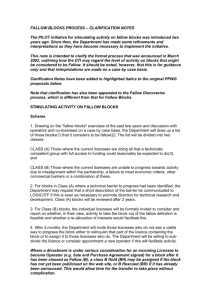ExerciseStrengRes
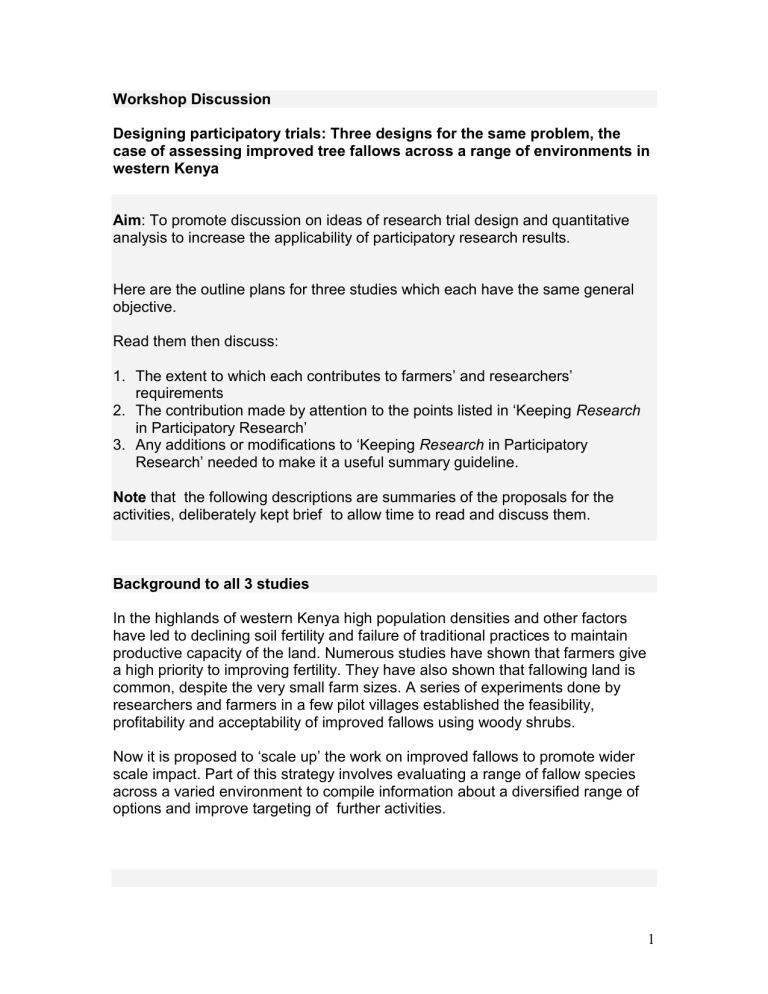
Workshop Discussion
Designing participatory trials: Three designs for the same problem, the case of assessing improved tree fallows across a range of environments in western Kenya
Aim : To promote discussion on ideas of research trial design and quantitative analysis to increase the applicability of participatory research results.
Here are the outline plans for three studies which each have the same general objective.
Read them then discuss:
1. The extent to which each contributes to farmers’ and researchers’ requirements
2. The contribution made by attention to the points listed in ‘Keeping Research in Participatory Research’
3.
Any additions or modifications to ‘Keeping
Research in Participatory
Research’ needed to make it a useful summary guideline.
Note that the following descriptions are summaries of the proposals for the activities, deliberately kept brief to allow time to read and discuss them.
Background to all 3 studies
In the highlands of western Kenya high population densities and other factors have led to declining soil fertility and failure of traditional practices to maintain productive capacity of the land. Numerous studies have shown that farmers give a high priority to improving fertility. They have also shown that fallowing land is common, despite the very small farm sizes. A series of experiments done by researchers and farmers in a few pilot villages established the feasibility, profitability and acceptability of improved fallows using woody shrubs.
Now it is propo sed to ‘scale up’ the work on improved fallows to promote wider scale impact. Part of this strategy involves evaluating a range of fallow species across a varied environment to compile information about a diversified range of options and improve targeting of further activities.
1
Study 1:
Objective
Generate the information researchers need to prepare recommendations for improved fallow species across a range of rainfall and soil types found in W.
Kenya.
Methods
1. The region will be stratified into 3 major soil types (sandy, gravelly and loam). A transect along a rainfall gradient will be identified within each stratum. 4 cluster centers will be chosen along each transect.
2. Around each cluster center 10 farmers will be found who are willing to participate. Criteria for participation include willingness to make at least
700m 2 available for the experiment and to continue it for 1 year (2 rainy seasons).
3. Participating farmers will be invited to the research station to see the design of the trial and be shown its management.
4. Each farmer will then establish, with the help of technicians, a 10x10m plot of each of the fallow species Sesbania sesban, Crotolaria grahamiana, C. ochroleuca, C. Pancillar, Tephrosia vogelii , T. candida and a natural fallow control plot, on land which has been cropped with maize for at least
3 seasons. After 1 year the fallows will be cleared, wood removed, and other biomass incorporated. A crop of maize will then be planted.
Measurements
1. Regular measurements of fallow species growth and biomass production by technicians.
2. Measurement of crop performance by technicians
3. Observations on pests and diseases, and weeds in the crops, made by farmers and technicians
4. Farmers assessments (ease of establishment and clearing fallows, effect on soil tillage, value of fuelwood produced)
Analysis and Reporting
1. Analysis of variance and GxE analysis of performance measures.
2. Mapping of recommendation domains for each species on basis of soil and rainfall.
3. Other data compiled into research reports.
4. All reports translated into extension booklets and given to participating farmers.
2
Study 2
Objective
To give farmers the information and resources to allow them to test a range of improved fallow species.
Methods
1. Select 12 communities in which we already have good working relationships with farmers groups.
2. At farmer group meetings introduce farmers to each of the fallow species
Sesbania sesban, Crotolaria grahamiana, C. ochroleuca, C. pancillar,
Tephrosia vogelii , T. candida , discussing their use and management.
Make seed available for plantings of up to 100m 2 for any species farmers are interested in testing.
3. Evaluate farmers’ reactions after 3 months, at the end of the fallow and after 1 post-fallow crop though group interviews.
Measurements
1. Farmer and group interviews using semi-structured questionnaires.
2. Matrix ranking of fallow species using a consensus of farmer opinion in each community. Species ranked, best, second-best, etc.
Analysis and Reporting
Compilation of all reactions into a single report. Presentation of report to each farmer group.
3
Study 3
Objective
To provide researchers and farmers with information about a range of improved fallow species suitable for use in diverse environments in W. Kenya.
Methods
1. Select 12 communities with which we already have good working relationships with farmer groups. Map their location with respect to the main soil types and rainfall gradients in the region. If there are large gaps in the rainfall x soil type map then choose further communities to fill those gaps, establishing contact with farmer groups or community-based organizations (CBO’s) in those villages.
2. Within each selected village assist the CBO to establish a ‘farmer research group’ of members interested in testing improved fallows.
3. Introduce the six fallow species Sesbania sesban, Crotolaria grahamiana,
C. ochroleuca, C. pancillar, Tephrosia vogelii and T. candida to each group, explaining their use and management, making seed available for farmers to plant at least 100m 2 of any species they wish.
4. Discuss the needs of experimentation with each group, including the comparison of 2 or more species, the baseline they wish to use for evaluation, bias and prior knowledge of the plots.
5. Monitor process and results
Measurements
1. Monitoring of trial establishment and management, including elicitation of farmers reasons for what they do.
2. Measurement of fallow and crop growth by technicians using rapid scoring methods
3. Systematic collection of data on all farms of factors judged by project staff or farmers to be critical in influencing performance
4. Farmers assessment of alternative species by matrix scoring (scores of 1 to 5) using criteria determined in groups. Data collected from each participating farmer including reasons behind ratings.
Analysis and reporting
1. Compilation of results from each farmer for discussion in farmer research groups, to obtain information on reasons for variability
2. G x E analysis to show performance and risk of each species under a range of biophysical, social and management conditions
3.
Synthesis of results as (i) suitability maps and (ii) qualitative information about each species to inform farmer decision making.
4







